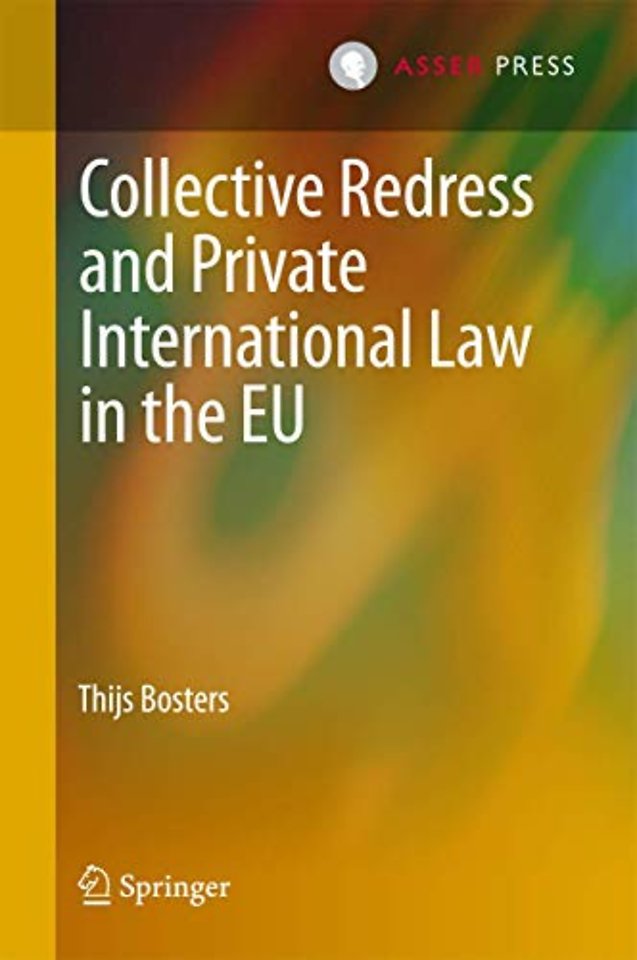Collective Redress and Private International Law in the EU
Gebonden Engels 2017 1e druk 9789462651852Samenvatting
This book specifically covers issues regarding jurisdiction and the recognition and enforcement of judgments in cross-border mass disputes relating to financial services. Collective redress mechanisms, legal mechanisms which can be used to resolve mass disputes collectively, are growing more important. Due to the global increase in cross-border trade and financial transactions, the number of cross-border mass disputes has increased.
In the EU, several prototypes of collective redress mechanism exist that can be used to resolve mass disputes and recently, aside from the EU’s recommendation on the drafting of laws relating to collective redress, a re-evaluation of the Brussels Regulation has also taken place as on 10 January 2015 the Brussels I-bis Regulation replaced the old Brussels Regulation dating from 2000.
In spite of a minor reference to collective redress in the Commission proposal, Brussels I-bis does not contain any provision relating to collective redress. As a result, many questions regarding cross-border mass disputes and the relevant private international law issues remain unanswered and unresolved. This book sets out to describe the most important prototypes by referring to actual collective redress mechanisms.
In addition, it also sets out how parties to such mass disputes can confer jurisdiction to courts in the EU and what the various pitfalls are. Moreover, the rules concerning the recognition and enforcement of judgments originating from a collective procedure are listed. As cross-border collective redress mechanisms and the rules of private international law to be used in such a context are still being developed, the goals of private international law and the goals of the referred collective redress mechanisms are analysed to provide an insight into how these sets of rules should and could be employed.
This book is primarily aimed at researchers, practitioners and lawmakers actively involved in and/or
professionally interested in the field of private international law and collective redress mechanisms and should prove very useful in providing them with a greater in-depth understanding of the issues at hand.
Trefwoorden
Specificaties
Lezersrecensies
Inhoudsopgave
U kunt van deze inhoudsopgave een PDF downloaden
1.1 Collective Redress and Cross-Border Mass Disputes
1.2 Parameters of This Book
1.3 Book Structure
1.4 Typologies/Classifications of Collective Redress Mechanisms in the EU
1.4.1 Public Law Mechanisms and Private Law Mechanisms
1.4.2 Aggregate Litigation and Representative Litigation
1.5 Goals of Collective Redress Mechanisms
1.5.1 Introduction
1.5.2 Efficient Legal Protection
1.5.3 Effective Legal Protection
1.5.4 Reduction of the Administrative Burden on the Judiciary
1.6 Goals of the Brussels Regulation
1.6.1 Introduction
1.6.2 Free Movement of Judgments
1.6.3 Rights of the Defence
1.6.4 Legal Certainty
1.6.5 Resolving a Dispute Before an Appropriate Court
References
Part I Collective Redress Mechanisms in the EU
2 German KapMuG Procedure
2.1 Introduction
2.2 Deutsche Telekom and KapMuG History
2.3 How a KapMuG Procedure Is Initiated
2.4 What Plaintiffs Can Achieve Through a KapMuG Procedure
2.5 Recent Experience with the Act, and Future Developments
References
3 Dutch Collective Action
3.1 Introduction
3.2 History of Collective Action
3.3 Parties That Can Bring a Collective Action?
3.4 Criteria for Bringing a Collective Action
3.5 The Result of Bringing a Collective Action
3.6 Recent Experience with Collective Actions
3.7 Future Developments
References
4 Dutch WCAM Procedure
4.1 Collective Settlement History
4.2 The Conditions for Arranging a WCAM Settlement
4.3 What Can Eventually Be Achieved with a WCAM Settlement
4.4 WCAM Case Law
4.4.1 Dexia Case
4.4.2 Vedior Case
4.4.3 Shell Case
4.4.4 Converium Case
4.5 Current and Future Developments
4.5.1 Amendments to the WCAM
4.5.2 Preliminary Questions Supreme Court
References
Part II Jurisdiction in Cross-Border Mass Disputes
5 Jurisdiction and the KapMuG
5.1 Introduction
5.2 Submission
5.3 Jurisdiction in Consumer-Related Matters
5.3.1 Application of Chapter II, Section 4 Brussels I-Bis
5.3.2 Jurisdiction in KapMuG Procedure Relating to Financial Products
5.4 Choice of Forum Agreement
5.4.1 Choice of Forum Agreement in Consumer-Related Matters
5.4.2 Choice of Forum Agreement in Non-Consumer-Related Matters
5.4.3 Conclusion
5.5 General Provision
5.6 Jurisdiction in Contractual Matters
5.6.1 Various Places of Performance
5.7 Jurisdiction in Tortious Matters
5.7.1 Place Where the Harmful Event Occurred or May Occur
5.8 Effect of Grounds of Jurisdiction on the Goals of Collective
Redress
5.8.1 Effective Legal Protection
5.8.2 Efficient Legal Protection
5.8.3 Administrative Burden of the Judiciary
References
6 Jurisdiction and the Dutch Collective Action
6.1 Introduction
6.2 Submission Rule
6.3 Jurisdiction in Consumer-Related Matters
6.4 Choice of Forum Agreement
6.4.1 Mass Dispute Relating to a Financial Product
6.4.2 Securities Mass Dispute
6.5 General Provision
6.6 Jurisdiction in Contractual Matters
6.7 Jurisdiction in Tortious Matters
6.8 Effect of Grounds of Jurisdiction on the Goals of Collective Redress
6.8.1 Effective Legal Protection
6.8.2 Efficient Legal Protection
6.8.3 Administrative Burden of the Judiciary
6.9 Conclusions
References
7 Jurisdiction and the WCAM
7.1 Introduction
7.2 Procedural Role of Parties and Applicability of the Brussels Regulation
7.3 Submission Rule
7.4 Jurisdiction in Consumer-Related Matters
7.5 Choice of Forum Agreement
7.5.1 Choice of Forum Agreement Between the Victims and the Perpetrator
7.5.2 Choice of Forum Agreement as Part of the Settlement Agreement
7.6 General Provision and Co-Defendants
7.6.1 Co-Defendants Pursuant to Article 8(1) Brussels I-Bis
7.7 Jurisdiction in Contractual Matters
7.8 Jurisdiction in Tortious Matters
7.9 Effect of Ground of Jurisdiction on the Goals of Collective Redress
7.9.1 Effective Legal Protection and Finality
7.9.2 Efficient Legal Protection
7.9.3 Administrative Burden of the Judiciary
7.9.4 Conclusion
References
8 Parallel Proceedings
8.1 Introduction
8.2 Lis Pendens
8.2.1 Requirements
8.2.2 Application of Lis Pendens Rule to Collective Redress Mechanisms
8.3 Related Actions
8.3.1 Requirements
8.3.2 Application of Related Actions Rule to Collective Redress Mechanisms
8.4 Conclusions
8.5 Parallel Proceedings and Collective Redress Goals
References
Part III Recognition and Enforcement of Foreign Collective Redress Judgments
9 Goals of the Brussels Regulation Regarding Jurisdiction
9.1 Interim Conclusions Regarding Jurisdiction
9.2 Goals of the Brussels Regulation
9.2.1 Legal Certainty
9.2.2 Most Appropriate Court
9.2.3 Preliminary Conclusions
Reference
10 Recognition and Enforcement of KapMuG Judgments
10.1 Introduction
10.2 ‘Judgment’ or Court Settlement?
10.3 Non-Recognition and Non-Enforcement of a KapMuG Judgment
10.3.1 Public Policy
10.3.2 Defaulting Defendant
10.3.3 Irreconcilable Judgment
10.3.4 Conflict with a Judgment Given in Another Member State
10.3.5 Summary
10.4 Goals of Collective Redress
References
11 Recognition and Enforcement in Relation to a Collective Action Procedure
11.1 Introduction
11.2 Cross-Border Effect on Third Parties
11.3 Enforcement in a Collective Action Procedure
11.4 Non-Recognition and Non-Enforcement in a Collective Action Procedure
11.4.1 Defaulting Defendant
11.4.2 Public Policy
11.4.3 Irreconcilable Judgment
11.4.4 Conflict with Judgment Given in Another Member State
11.4.5 Summary
11.5 Goals of Collective Redress
References
12 Recognition and Enforcement of a WCAM Judgment
12.1 Introduction
12.2 ‘Judgment’ or Court Settlement
12.3 Enforcement of a WCAM Judgment
12.4 Non-Recognition and Non-Enforcement of a WCAM Judgment
12.5 Defaulting Defendant
12.5.1 Public Policy
12.5.2 Irreconcilable Judgment
12.5.3 Conflict with Judgment Given in Another Member
State
12.5.4 Summary
12.6 Goals of Collective Redress
References
13 Goals of the Brussels Regulation Regarding Recognition and Enforcement
13.1 Interim Conclusions Regarding Recognition and Enforcement
13.2 Goals of the Brussels Regulation
Part IV Making Cross-Border Collective Redress Possible
14 Summary
14.1 Typologies of Collective Redress Mechanisms
14.2 Application of the Rules on Jurisdiction
14.2.1 KapMuG Procedure
14.2.2 Dutch Collective Action
14.2.3 WCAM Procedure
14.2.4 Lis Pendens Rule
14.3 Application of the Rules of Recognition and Enforcement
of Foreign Judgments
14.3.1 KapMuG Procedure
14.3.2 Collective Action
14.3.3 WCAM Procedure
14.4 Principles of Collective Redress and the Brussels Regulation
14.4.1 Principles of Collective Redress
14.4.2 Goals of the Brussels Regulation
14.5 Applicability of Brussels Regulation and Recommendations
Reference
15 Relevant Developments and Possible Future Research
15.1 Introduction
15.2 Consultation ‘Towards a Coherent Approach to Collective Redress’
15.3 Recommendation ‘Towards a European Horizontal Framework for Collective Redress’
15.4 IBA Guidelines
15.5 Insolvency Regulation
15.6 Alternative Solutions and Possible Future Research
References
Bibliography
Case Law
Curriculum Vitae
Index
Anderen die dit boek kochten, kochten ook
Rubrieken
- advisering
- algemeen management
- coaching en trainen
- communicatie en media
- economie
- financieel management
- inkoop en logistiek
- internet en social media
- it-management / ict
- juridisch
- leiderschap
- marketing
- mens en maatschappij
- non-profit
- ondernemen
- organisatiekunde
- personal finance
- personeelsmanagement
- persoonlijke effectiviteit
- projectmanagement
- psychologie
- reclame en verkoop
- strategisch management
- verandermanagement
- werk en loopbaan









